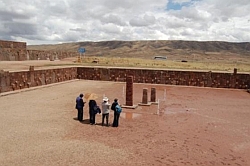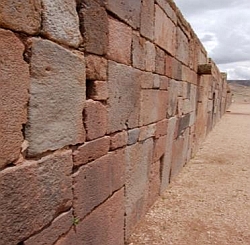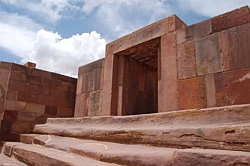For a moment I understood why some would think that aliens had constructed these commanding ancient walls. Not even my site brochure would fit into the mortarless joints that separated the monstrous monoliths, whose journey to their resting place is not easily explained.
I was in Tiwanaku in western Bolivia, 44 kilometers west of La Paz and close to the border with Peru. The city was occupied between 500 and 950 AD before a drought pushed the population out of the region[1]. The residents of what would have been then an imposing city left no written record of their story, leaving the majority of their history to the conjecture of modern archaeologists and science fiction enthusiasts.
The site sits 13,000 feet above sea level in the dry, flesh-colored Andes Mountains[2]. It is believed by archaeologists that Tiwanaku was originally inhabited by up to 30,000 people at its peak, and was sprawled out over 2.6 square kilometers[3]. Although there are other Tiwanaku sites in the area, such as Lukurmata, a ceremonial center, Tiwanaku itself was the most important, serving as a religious and administrative capital of a vast empire that pre-dated the famed Incas[4].
All that now remains for tourists to visit are the walls and foundations of a few buildings, as well as a few standing gateways, on a patch of land that occupies only a small fraction of the original expanse. The most important of these is arguably the cracked Gateway of the Sun, which has become something of an icon in Bolivia. It symbolizes the importance of the culture through images of “Staffed Gods,” anthropomorphic figures bearing staffs that were most likely ritual practitioners, according to archaeologists[5].
Although much of the city has not stood strong against the test of time, what still exists and what is known of what existed is more than enough to stir up questions about the mystery of the place.
Staring up at the walls that dwarf my 5’ 10’’ frame, my first question is: How did the enormous stones get to Tiwanaku? Great feats of strength must explain how the red sandstone blocks, which can weigh up to 130 tons each and were used for the buildings and walls, traveled 10 kilometers from the nearest quarry[6]. It is also difficult to explain how a culture without 18-wheelers could manage the transport of andesite, green stones that were used for the intricate decorative carvings. Each weighed up to 40 tons and was brought to Tiwanaku from the other side of Lake Titicaca, a distance of 90 kilometers over water and another ten over land[7].



Pointing to the remains of what appeared to be ancient canals, my Bolivian tour guide explains the popular theory, which says the blocks were transported by reed rafts on rivers and canals to Tiwanaku after being hauled on logs from their original sites. Small pools of water rest in these canals now, showing that they were once capable of holding liquid, but imagining them as them as the great tools of movement that they once were requires a stretch of my imagination.
Assuming that my tour guide is correct, and that the transportation was indeed possible, the mysteries of Tiwanaku are still far from solved. Once the giant stones arrived, how did the buildings’ architects find a way to stack these blocks with perfect precision? No mortar was used, and nor was it needed, because alone the joints seem perfectly crafted, even to a modern eye.
A creative few have clung to an imaginative theory that claims such achievements could have only been accomplished by technical advancements not known to mankind at the time. These theorists say the precision of the joints and the magnitude of the structure must have been the result of aliens and their extraterrestrial techniques.
One such theorist, Erich von Daniken, included Tiwanaku in his book, “Chariots of the Gods,” which he published in 1968. In it, he claims that many of the famous ancient structures that have fascinated the world for centuries were only possible through the technology given to these cultures by visitors from other planets who were seen as gods[8]. My guide mentioned an angular rock structure on the site, which adherents of the alien theory claim was a launching pad for spacecraft.
Von Daniken also includes the nearby Nazca lines in his theory, as well as Stonehenge and the Egyptian Pyramids[9]. The aliens, he believes, were globally influential.
Another theory came from an early 20th century Austrian astronomer, H.S. Bellamy, who didn’t believe that advanced civilizations could exist at such altitude and posited that the city was a result of the collision of the Earth with one of its former moons[10].
Even the Incas, who discovered Tiwanaku hundreds of years after it had been abandoned, had their own theories to relieve their discomfort with the idea that an advanced culture could have existed before their own. They claimed that the first Incas were created with clay from area by the deity Viracocha, and that the monoliths stand as a solemn reminder of the act[11].
I remain skeptical of the more extreme theories, though I can admit it is easier to explain the mysteries with tales of visitors from space than to imagine all of the blood, sweat, tears and probably lives that went into the construction of this amazing city.
Places like Tiwanaku remind travelers what incredible work mankind is capable of. This is one of the reasons people travel, after all; to see up close what remains of this world’s history so that we might know how we got to where we are and provide insights to where we are going.
I leave Tiwanaku still pondering my questions, but also feeling uniquely privileged to experience such a remarkable, and little understood, period of human history.
*****
Interested in making the trip yourself?
I traveled in November of 2009 and used a local guide named Rene Jaldin Andrade, who was based out of La Paz. If you decide to hire a local guide on your own rather than through a travel agency, it’s always good to make sure he or she is certified by ASOGUIATUR, the local association of tour guides.
How to get there:
Most visitors come for the day from La Paz. For the cheapest travel option, catch a bus outside of the main cemetery (“cementerio” in Spanish). The trip takes between one and one and a half hours and costs less than $2. You can also ride on a tour bus service for about $1.50. Try Transportes Tiwanaku (Tel. 7191-4889). Another option is to hire a taxi from La Paz to take you for a round trip journey. Including wait time, this will cost around $30 – $40, and most hotels can help you find a safe driver. The last option, and perhaps the most popular, is to arrange a tour with a bilingual guide from a travel agency in La Paz. Most travel agencies will offer half day or full day tours. Try Transporte Turistico Bolivia (Tel.
231-6971, http://www.transporteturisticobolivia.com/).
Getting in:
The main site costs $10 and is open from 9:30 a.m. – 4 p.m. The onsite museum, Museo Litico Monumental, also costs $10 and is open from 9 a.m. – 5 p.m.
Where to stay:
Most travelers choose to visit Tiwanaku on a day trip from La Paz, but if you would like to stay the night, there is a small village next to the site. Try the Gran Hotel Tiwanaku (Tel. 289-8548, Bolivar 903), the nicest hotel in town, and at $30 – $40 a night per person, also a good deal. They also have a restaurant.
Footnotes:
- [1]“Tiwanaku.” (Center for Advanced Spatial Technologies, University of Arkansas and the University of Pennsylvania Museum of Archaeology and Anthropology, 2007). http://cast.uark.edu/projects/tiwanaku/about.html.
- [2]Ibid.
- [3]Mutic, Anja, Kate Armstrong, and Paul Smith. Bolivia. (Lonely Planet Publications Pty Ltd, 2010) 94.
- Kolata, Alan L.The Tiwanaku: Portrait of an Andean Civilization.(Wiley-Blackwell: December 15, 1993).
- Silverman, Helaine.Andean Archaeology Volume 2. (Malden, MA: Blackwell Publishing, 2004).
- Harmon, Paul. “Experimental Archaeology.” Archaeology Magazine. (Archaeological Institure of America, 2004).
- Ibid.
- “Tiwanaku.”
- Ibid.
- Ibid.
- Ibid.





 Mac, our regular contributor writes that “Ribblesdale Goat is a modern vegetarian (I had never heard the vegetarian angle) hard cheese created in 1982 by Iain and Christine Hill. Ribblesdale goat is highly valued for its fresh simple flavor with its suggestion of chicory, almonds, and wild herbs from the misty Yorkshire hills. Ribblesdale Goat won a Bronze Award in the 1996 British Cheese Awards. Although normally a goats cheese it is also available from ewes milk and a smoked cheese . Ribblesdale cheese can be served as a table cheese or for grated toppings. All Ribblesdale Cheeses supplied are handmade and waxed coated giving the cheese a long shelf time of approximately 80 days. Sadly Iain Hill passed away in November 2006 but is succeeded by his niece Iona Hill who maintains the family tradition. Suitable for vegetarians, suitable for freezing…”
Mac, our regular contributor writes that “Ribblesdale Goat is a modern vegetarian (I had never heard the vegetarian angle) hard cheese created in 1982 by Iain and Christine Hill. Ribblesdale goat is highly valued for its fresh simple flavor with its suggestion of chicory, almonds, and wild herbs from the misty Yorkshire hills. Ribblesdale Goat won a Bronze Award in the 1996 British Cheese Awards. Although normally a goats cheese it is also available from ewes milk and a smoked cheese . Ribblesdale cheese can be served as a table cheese or for grated toppings. All Ribblesdale Cheeses supplied are handmade and waxed coated giving the cheese a long shelf time of approximately 80 days. Sadly Iain Hill passed away in November 2006 but is succeeded by his niece Iona Hill who maintains the family tradition. Suitable for vegetarians, suitable for freezing…”